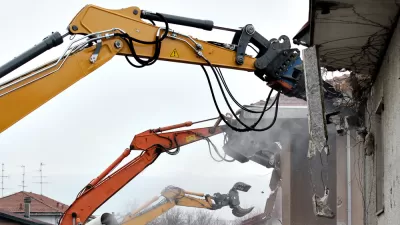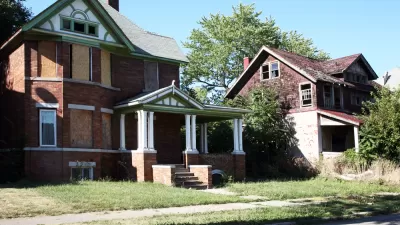A response to the conventional thinking about demolitions as the antidote to blighted, vacant properties and the negative effects that follow.
Columnist Dan Rodricks has a prescription for the city of Baltimore that departs from conventional thinking about demolishing vacant and blighted properties.
First Rodricks summarizes the arguments that support demolition campaigns:
- "People who call for bulldozing whole blocks seem to think that a developer will suddenly find the flattened area wildly attractive and build new, well-appointed "townhomes" for Baltimore's growing professional class."
- "Some people believe the demolition of old, decrepit Baltimore will create grand opportunities for more green space — vast city parks and sprawling urban gardens."
- "Some believe that, at the very least, more demolition will give areas of the city a psychological lift and a break from crime."
Maryland Governor Larry Hogan himself supports these arguments, as he states in a September 18 op-ed for The Baltimore Sun. In that op-ed, Governor Hogan promises to "advance a plan to knock down blocks of derelict buildings that tarnish communities across Baltimore, replacing them with parks and other open spaces."
Rodricks, however, thinks the governor would better support the city by sending money, rather than bulldozers. In his estimation, revitalization will require a complex policy agenda:
"Resolving Baltimore's vacant house problem involves vigorous housing code enforcement; going to court to seize properties; respecting the rights of homeowners who live in or near blighted properties and, if necessary, relocating them (at significant expense to taxpayers); getting developers to invest; giving financial incentives to homebuyers willing to rehabilitate houses; dealing with neighbors and raw emotions that can sink even small projects with great merit."
FULL STORY: How Hogan can best help city deal with vacants

Alabama: Trump Terminates Settlements for Black Communities Harmed By Raw Sewage
Trump deemed the landmark civil rights agreement “illegal DEI and environmental justice policy.”

Planetizen Federal Action Tracker
A weekly monitor of how Trump’s orders and actions are impacting planners and planning in America.

The 120 Year Old Tiny Home Villages That Sheltered San Francisco’s Earthquake Refugees
More than a century ago, San Francisco mobilized to house thousands of residents displaced by the 1906 earthquake. Could their strategy offer a model for the present?

In Both Crashes and Crime, Public Transportation is Far Safer than Driving
Contrary to popular assumptions, public transportation has far lower crash and crime rates than automobile travel. For safer communities, improve and encourage transit travel.

Report: Zoning Reforms Should Complement Nashville’s Ambitious Transit Plan
Without reform, restrictive zoning codes will limit the impact of the city’s planned transit expansion and could exclude some of the residents who depend on transit the most.

Judge Orders Release of Frozen IRA, IIJA Funding
The decision is a victory for environmental groups who charged that freezing funds for critical infrastructure and disaster response programs caused “real and irreparable harm” to communities.
Urban Design for Planners 1: Software Tools
This six-course series explores essential urban design concepts using open source software and equips planners with the tools they need to participate fully in the urban design process.
Planning for Universal Design
Learn the tools for implementing Universal Design in planning regulations.
Clanton & Associates, Inc.
Jessamine County Fiscal Court
Institute for Housing and Urban Development Studies (IHS)
City of Grandview
Harvard GSD Executive Education
Toledo-Lucas County Plan Commissions
Salt Lake City
NYU Wagner Graduate School of Public Service





























